Profile
Review of Lake Fork
Lake Fork is shaped like a big V with the bottom of the V at the dam. The big V is 27,264 acres and has 315 miles of shoreline and lots of small arms and coves coming off the V. The maximum depth is 70 feet and the water is a tinted brownish color.
Lake Fork is best known for fishing, which is excellent for largemouth bass and catfish. In fact, more than 65% of the Texas Top 50 largest bass (including the current state record) and more than half of those entered in the Toyota ShareLunker Program, were caught from Lake Fork! That's the good news, the bad news is that 80% of the standing timber was left which means that the lake is loaded with tree stumps which doesn't make it one of the best lakes for scenery, cruising. or other water recreation.
The vast majority of the lake is not developed and the shoreline is gently rolling and tree lined.
Map
Sorry, no records were found. Please adjust your search criteria and try again.
Sorry, unable to load the Maps API.
We have cruised the lake a couple times looking for something to see and do and haven't had any luck. Since most of the lake is standing timber, you need to follow the buoys that mark open lanes where the timber has been cut. The open lanes may take you to some good water for swimming or boarding. Down by the dam is some open water which is good for boarding, tubing, or skiing. But beware, the stumps are everywhere.
You can cruise by The Links at Lands End and watch the golfers try to par a couple holes while you swim or fish. But don't get too close or you may find a golf ball coming your way. The Links at Lands End is an excellent golf course and they also have a great Stay & Play package that could include a guided fishing trip.
Again, we didn't find a lot of things to see or do on the lake and it's not a lot of fun exploring the lake when you need to concentrate on staying in the boat lanes through the stumps and making sure don't hit any. There are a couple marinas that we heard you can boat up to for food and sometimes music, but we didn't look real hard for them.
If you don't have a boat then think about hiring a fishing guide or renting one, but take out the insurance.
We haven't spent a lot of time exploring the area around Lake Fork, so we can't help you with other things to see and do. We do know that there are lots of fishing tournaments during the year and several have live music sometime during the event. There are a couple good golf courses - The Links at Lands End or Lake Fork Golf Course
We heard that one of the marinas occasionally has live music - I think it was Oak Ridge Marina. The Links at Land's End has an excellent restaurant that serves breakfast and lunch during the week and all three meals on the weekend and the food is excellent. Call them and they might tell you where to park the boat and make arranges for them to pick you up in a golf cart.
Make sure that you scout the area carefully before you start towing anyone. Down by the dam may be the best bet for boarding or skiing or tubing.
Angling Opportunities
Largemouth bass is the most popular sportfish in this reservoir. A combination of restrictive harvest regulations, stocking of Florida strain largemouth, and abundant habitat has contributed to Lake Fork's development as one of the country's premier trophy bass lakes. More than 65% of the Texas Top 50 largest bass (including the current state record) and more than half of those entered in the Toyota ShareLunker Program, were caught from Lake Fork. Crappie fishing is generally good, especially in standing timber and under the lake's numerous bridges. Channel catfish provide an excellent sport fishery, which has increased in popularity and notoriety in recent years. White bass have been slowly increasing in abundance and provide an additional sportfish species in the reservoir. Yellow bass or “barfish” are often caught during the winter months, often associated with largemouth bass. These fish tend to be relatively small but they are great table fare and they are as tasty as crappie. Sunfish, primarily bluegill, offer additional opportunities for anglers during spring and summer.
Fishing Cover/Structure
Flooded timber is found throughout Lake Fork and provides excellent fish habitat. Although access through the reservoir is provided by numerous buoyed boat lanes, submerged timber represents a substantial hazard, so care should be exercised while boating in all areas. Areas containing hydrilla, boat houses and docks, and lake points have historically provided some of the best fishing for largemouth bass. Fish will also congregate around bridge pilings and artificial brush piles.
Tips & Techniques
Largemouth bass anglers are most successful on this reservoir during the spring, fall, and winter months. Spinnerbaits, plastic worms and lizards, jigs and lipless crankbaits are all popular lures during peak fishing in the spring (mid-February to April) when fishing is concentrated along the shoreline for spawning fish. Nightime fishing during the hot summer months can be very productive and a good way to beat the Texas heat. At this time, plastic worms, spinnerbaits, crankbaits and topwaters are often used. During late summer and early fall, when fish are schooling, crankbaits and topwater lures can be very effective. In winter jigging spoons, jigs and crankbaits are most productive.
Crappie anglers concentrate their efforts in deep water near the dam during the winter months. In late spring and early fall, most anglers fish for crappie under the bridges (Highway 154, Highway 515, CR 2946 and CR 514). Live minnows and crappie jigs are among the most popular baits used. The catfish population is dominated by channel catfish, but also includes flathead and a few large blue cats. Stinkbait and cutbait work well for channel cats, while live bait is preferred for flatheads. Anglers occasionally catch large blue catfish. Sunfish such as bluegill and redear can be caught in early summer, in shallow water, using crickets, earthworms and small spinners. During the remainder of the year they can be caught using the same baits around piers, boathouses and submerged humps.
White bass can grow exceptionally large in Lake Fork due to abundant prey species. Jigging spoons and live baitfish work well for yellow and white bass. When white bass are schooling, topwater baits and small crankbaits can be especially effective.
Above information is thanks to Texas Parks & Wildlife
The Links at Land's End has a great golf Stay & Play offering, but not on the water. There are several other options for staying on or near the lake but none that we have visited or stayed at. One of the best lodging options that we saw looks like Lake Fork Lodge - right on the water, ramp, slips, and it looks very nice. Use this Lake Fork Map to find some options.
Texas Parks & Wildlife has a map of all the ramps and marinas.
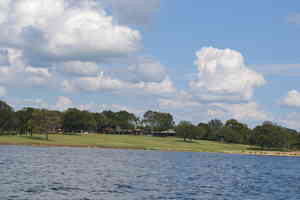
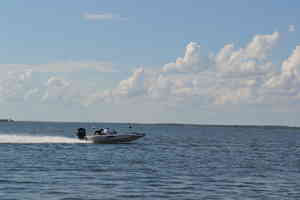
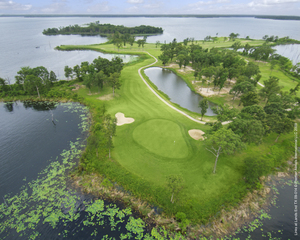

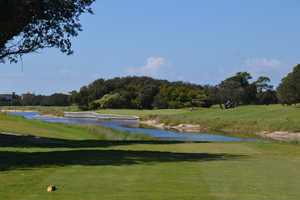
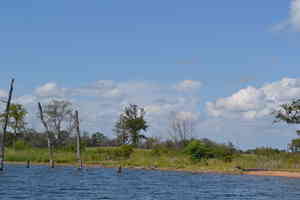
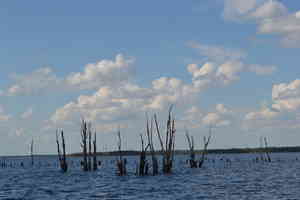
1 Review on “Fork”
This is our official Texas Outside rating